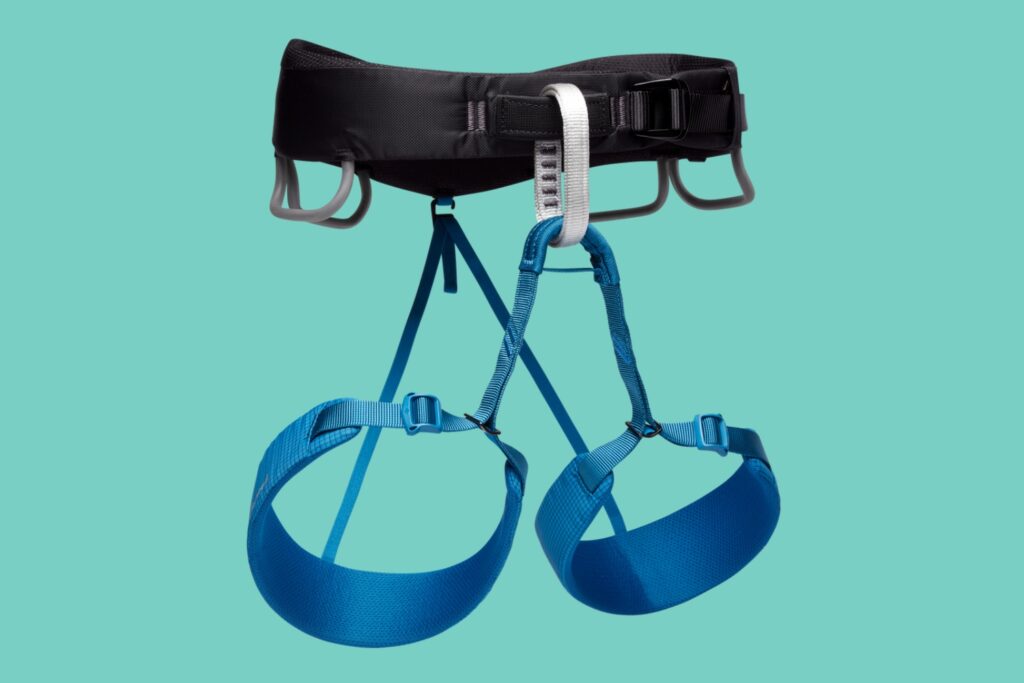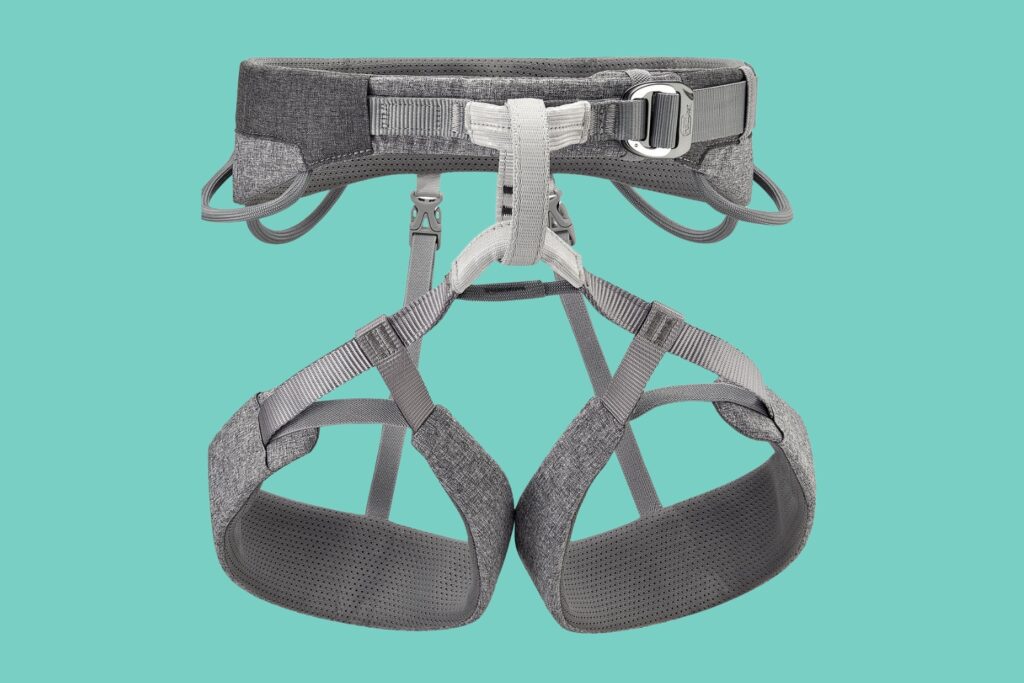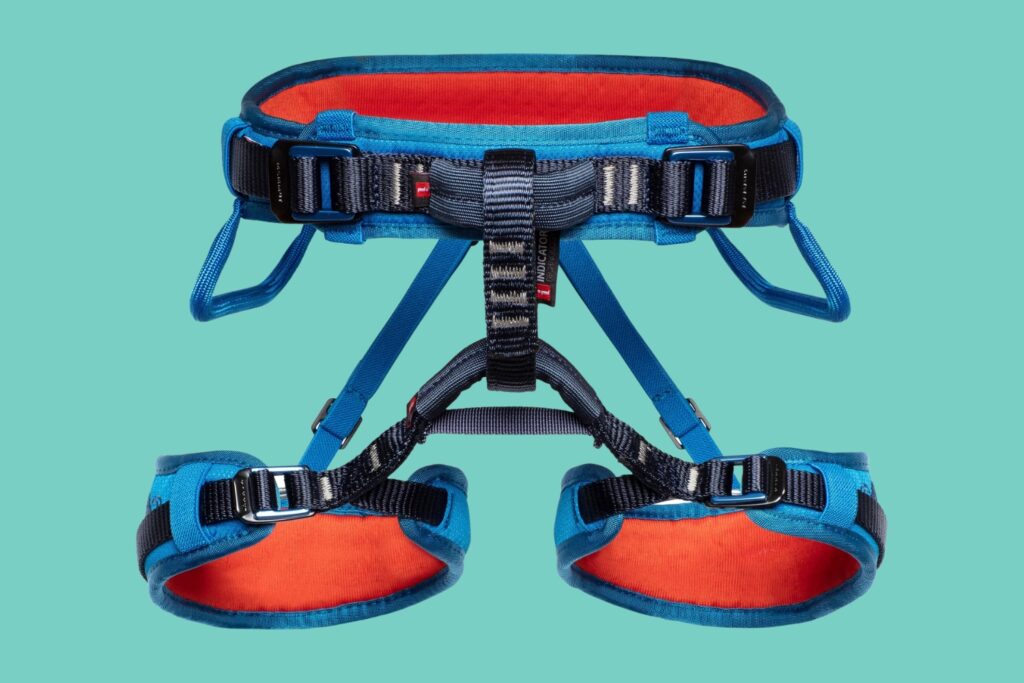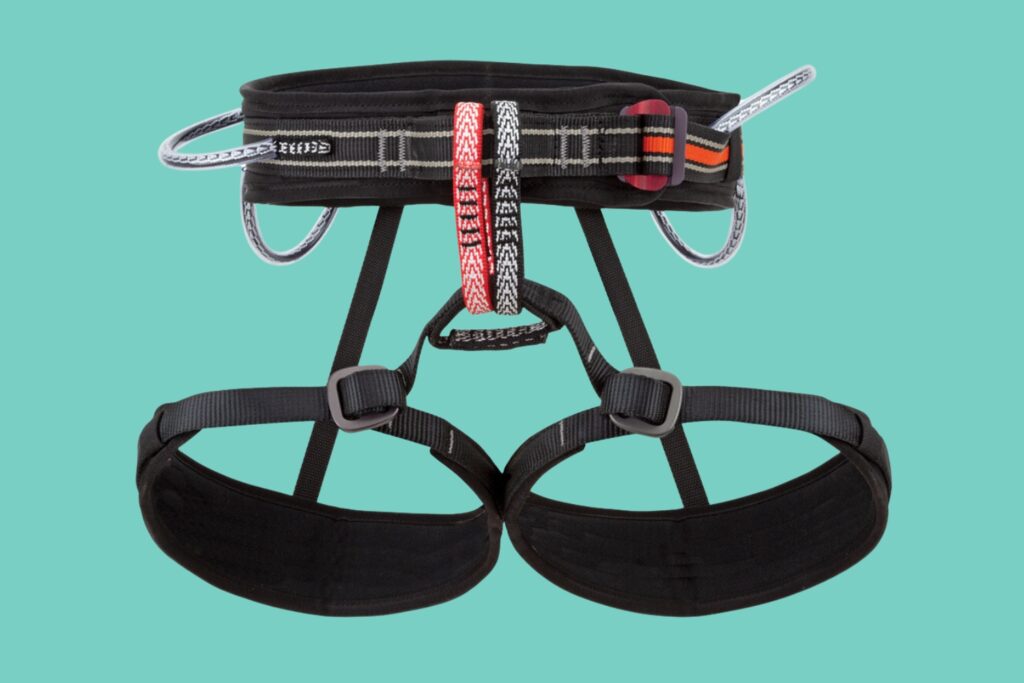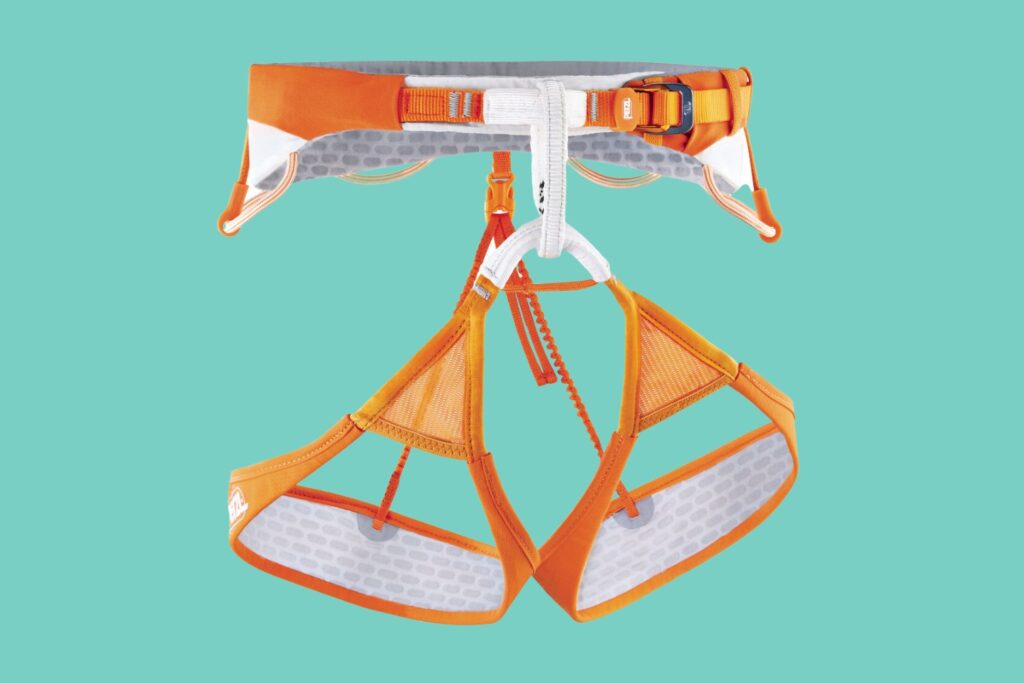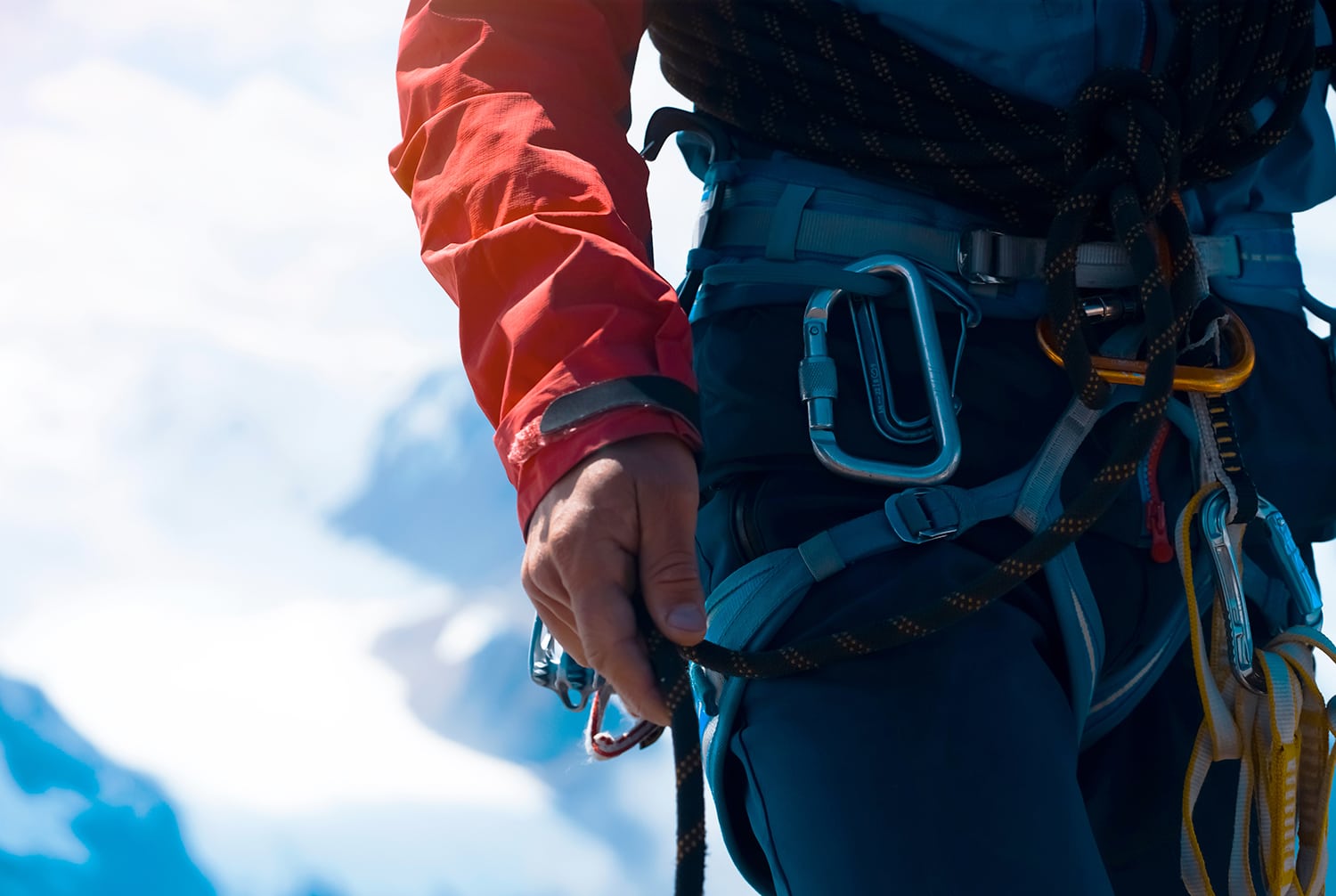
The 11 Best Climbing Harnesses (2024 Expert Guide)

By
Published on July 5, 2023
Updated on February 19, 2024
The humble rock climbing harness may not receive as much hype and coverage as the climbing shoe. But picking the right harness is often just as crucial to your success on the wall… and even more crucial to your safety!
Whether you’re lapping 15-meter plastic routes at the climbing gym or scaling a 3,000-foot multi-pitch in Yosemite, your harness is your only line of defense against gravity. It’s not only where you tie in but also where you’ll carry your gear and attach your belay device to keep your friends secure while they’re climbing.
In this article, I’ll dive into the top climbing harnesses of 2024, covering all the demographics. It doesn’t matter if you’re shopping for a harness for your 9-year-old crusher, looking for a lightweight, streamlined harness for hard sport burns, or hoping to purchase a harness for your next 5,000-meter peak. We’ve got ’em all laid out here!
Our Method

Before we get started, let’s talk about why you should even listen to what I’m saying here.
My name is Owen Clarke. I’m a veteran climbing writer and former editor and columnist for the climbing magazines Rock and Ice, Climbing, and Gym Climber. I’ve written about climbing for publications ranging from NPR to Travel + Leisure to Outside Online and my writing here at Climbing House.
As a lifelong climber and climbing journalist, I’ve worn almost every harness on this list at one time or another. For those that I haven’t tested personally, I’ve talked other testers, friends and colleagues, scoured the web for customer reviews, and made conclusions based on my knowledge of material and design choices.
That said, this is not a holistic review of climbing harnesses. This is merely a collection of what I believe to be the best climbing harnesses on the market right now, based on my extensive experience and judgment.
Our Selection

Comparison Table
| Climbing Harness | Weight | Leg Loop Style | Gear Loops | Best For | Top Offer |
|---|---|---|---|---|---|
Black Diamond Momentum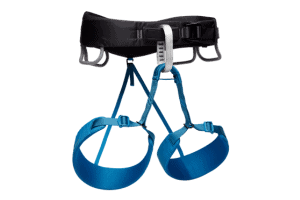 | 10.6 oz/302 g | Adjustable | 4 | Beginners | Check prices |
Black Diamond Solution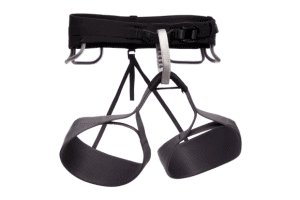 | 11.6 oz/330 g | Fixed | 4 | Sport Climbing | Check prices |
Petzl Sama | 14.6 oz/415 g | Fixed | 4 | Indoor Climbing | Check prices |
Mammut Ophir Kids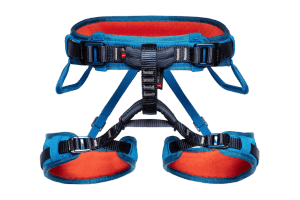 | 10.6 oz/302 g | Adjustable | 2 | Kids | Check prices |
Black Diamond Solution Guide | 13.9 oz/394 g | Fixed | 5 | Trad/Multi-Pitch Climbing | Check prices |
Petzl Selena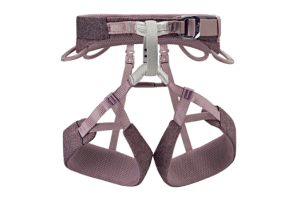 | 14.8 oz/420 g | Fixed | 4 | Women | Check prices |
Metolius Safe Tech All Around Climbing Harness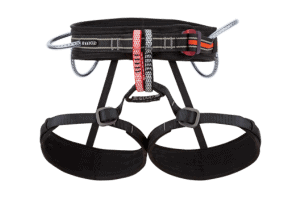 | 19 oz/539 g | Adjustable | 4 | Bigger People | Check prices |
Petzl Sitta | 9.5 oz/270 g | Fixed | 4 | Alpine and Ice Climbing | Check prices |
Black Diamond Couloir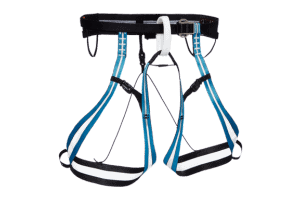 | 4.7 oz/135 g | Fixed | 2 | Mountaineering | Check prices |
Petzl Simba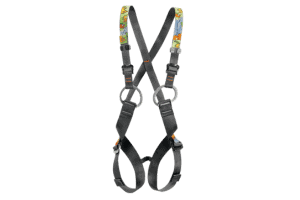 | si13.8 oz/391 g | Adjustable | n/a | Full-Body Harness | Check prices |
1. Black Diamond Momentum: Top Pick for Beginners
Important Specs
Weight: 10.6 oz/302 g
Min to Max Waist Size: 24″ to 45″
Gear Loops: 4
Leg Loop Style: Adjustable
The stalwart Momentum has been around for years and is certainly one of the best climbing harnesses for beginners. In fact, it was my first climbing harness. At this price point ($65), you won’t find much better. Sure, it’s not perfect, and when I upgraded, I was particularly impressed by the additional padding and breathability that a higher-priced harness can offer without upping weight, but the Momentum is light, relatively durable, and comfortable enough for a solid session.
Simply put, Momentum has everything you need to learn the ropes. The pre-threaded “Speed Adjust” waistbelt buckle makes it easy to safely take this harness off and on without worrying about doubling-back, the adjustable leg loops are quick to cinch and loosen, an adjustable rear elastic riser fine-tunes fit, and four pressure-molded gear loops make enough space for most single and multi-pitch endeavors.
Pros
Cons
2. Black Diamond Solution: Best Sport Climbers
Important Specs
Weight: 11.6 oz/330 g
Min to Max Waist Size: 27″ to 39″
Gear Loops: 4
Fixed Loops (Legs)
At $75, the Black Diamond Solution is just $10 more than its beginner-focused cousin the Momentum, but if you’re looking specifically for a sport climbing harness or top roping harness, it’s a far superior product in most respects. For one, it’s still very lightweight (only an ounce heavier, at 11.6 oz/330 g) but it’s far more comfortable, with three simple strands of low-profile webbing in the fixed leg loops and waist to disperse your weight without any bulky padding. In fact, this is one of the most comfortable harnesses I’ve ever worn, sport climbing or otherwise.
It’s kind of surprising because the Solution is barebones in terms of padding (i.e. it’s nonexistent). But Black Diamond’s “Fusion Comfort” weight distribution works wonders. I very rarely get pressure points wearing this harness, so I often end up taking it on longer missions, not just sport climbing outings. The leg loops are fixed, so you can slip in and out of the harness quickly (great for the gym and sport crag) and the overall harness is very slim and packable. The four gear loops are quite small, so it’s not a good choice for trad climbing or ice climbing. (However, the Solution Guide model, below, fixes this, with an additional fifth gear loop and oversized front loops).
Pros
Cons
3. Petzl Sama: Ideal for Indoor Climbing
Important Specs
Weight: 14.6 oz/415 g
Min to Max Waist Size: 28″ to 39″
Gear Loops: 4
Fixed Loops at the Legs
The Petzl Sama isn’t as cheap as the Momentum, but at $80, it’s still a fairly affordable harness and a serious notch up in the comfort category. It’s frequently ranked in “Best Value” categories, but I think the Sama is also a stellar indoor harness, and really perhaps the best all-around climbing harness on a budget if you prefer real padding over the Solution’s minimalist, “weight distribution” style of comfort. If you’ve moved out of the “beginner climbers” bracket and are looking for a gym harness that can stick with you as you transition outside, the Sama is a great choice.
Really, both this and the Solution (above) could make for great indoor harnesses, but while the Sama is quite similar in price and target to the Solution, I find the former to offer more space (and a more intuitive design) for carrying gear, so it’s probably the better all-rounder of the two. Comfy padding on the legs and waist, paired with an easy-to-adjust waistbelt, add to its appeal. The Sama may be heavy (with the medium weighing in at 14.6 oz/414 g) but for an indoor harness weight shouldn’t be a concern. Your approach is just from the parking lot to your gym’s front door 🙂
Pros
Cons
4. Mammut Ophir Kids: Our Recommendation for Children
Important Specs
Weight: 10.6 oz/302 g
Min to Max Waist Size: 20″ to 26.7″
Gear Loops: 2
Leg Loop Style: Adjustable
When you’re looking for a harness for kids, the main priority should probably be safety, followed by comfort. Another factor is that you should be thinking about both things from your kid’s perspective and your perspective. In other words, you need to consider what it’s like for YOU to take the harness on and off your kid, what it’s like for YOU to adjust the harness, and so on. It can be harder than you might think to work with a harness on someone else’s body, particularly a wriggling, energetic kid.
The Ophir Kids makes things easy, with twin gear loops that are very large and stick out from the harness, making it easy to clip gear onto your kid. The dual waist buckles are well-designed, making it easy to grab and adjust the harness yourself from either side and simple for kids to adjust on their own. The adjustable leg loops are equally intuitive. Synthetic reinforcements on the webbing ends prevent the buckles from unthreading, and burly padding helps reduce wear and tear on the tie-in points. The Ophir Kids also comes with a place to clip a chalk bag, and the perforated foam waist belt is both comfortable and breathable.
Pros
Cons
5. Black Diamond Solution Guide: For Trad/Multi-Pitch Climbing
Important Specs
Weight: 13.9 oz/394 g
Min to Max Waist Size: 27″ to 39″
Gear Loops: 5
Leg Loop Style: Fixed
A twist on the Solution, Black Diamond’s Solution Guide is far and away the most complete climbing harness for trad and multi-pitch endeavors. This harness takes what makes the Solution so great (comfort) and adds features and a design to make all-day (or multi-day) climbs viable. Among other changes, the Solution Guide adds a fifth gear loop on the back and makes the two front gear loops much larger to accommodate cams. Like the Solution, it’s a very comfortable harness, and it holds up well under the wear and tear you can expect from any trad or multi-pitch climbing adventure.
There aren’t any ice clipper slots, so frozen fiends may go wanting, and at nearly 14 oz/400 g, it’s heavier than some competitors. Like the Solution, the leg loops are fixed, which may be a pro or a con depending on your preference, but for most climbers, the fixed leg loops simply save weight, reduce bulk, and make on-off easier. All told, if you’re looking for a trad climbing harness, the Solution Guide will likely sate your appetite, and at a price point ($100) that remains pretty reasonable.
Pros
Cons
6. Petzl Selena: Top Pick for Women
Important Specs
Weight: 14.8 oz/420 g
Min to Max Waist Size: 25.6″ to 36″
Gear Loops: 4
Leg Loop Style: Fixed
Ultimately, essentially all of the products on this list also have equally good women’s variants. The Women’s Solution Guide (1) is an equally good trad and multi-pitch harness for women as it is for men, and the same can be said of the Women’s Momentum (2) when it comes to a beginner’s harness. Both of those are standout choices.
To avoid repeating names, however, I’ve given this to Petzl’s Selena, which offers something unique for climbers of the fairer sex (with a certain build). The lady’s version of the Sama, the Selena is one of those women’s climbing harnesses that folks either love or hate, but many female climbers are staunch advocates. The recently-updated Selena adds padding to the waistbelt, upping comfort at the cost of breathability.
In lieu of adjustable leg loops, the Selena’s accommodate a variety of thigh sizes using an elastic spreader, and the waistbelt is designed to wrap around your hips (not your waist), which makes it a much more comfortable harness for many female climberItst’s versatile waist and leg loops, paired with a unique build, offer a particularly comfy fit for those with a shorter rise. This is very climber-specific, however, so it really helps to try this one on before you click “BUY.”
Pros
Cons
7. Metolius Safe Tech All-Around Harness: Fantastic Option for Bigger People
Important Specs
Weight: 19 oz/539 g
Min to Max Waist Size: 27″ to 41″
Gear Loops: 4
Leg Loop Style: Adjustable
As a larger climber, it can be hard to find a harness that fits comfortably. For this entry, I checked around and noted that the Metolius Safe Tech All-Around is generally regarded as one of the top choices for bigger people. It’s a pretty expensive harness ($130), but it’s designed to be uber-redundant and error-proof, doubling up on all common harness weak points (even adding dual belay loops) to make for a safe, comfortable, and surprisingly versatile harness. The real boon here for larger folks is that the All-Around Climbing Harness is designed so both the waist and adjustable leg loops can be completely undone, allowing you to put the harness on without having to “slip” in. It’s also very heavily padded, offering a high level of comfort for heavier climbers.
The Edelrid Jayne (3) is another strong contender specifically for bigger female climbers. Plus-size climber Sam Ortiz wrote an extensive guide (Plus Size Climbing Harnesses: Resources and Measurements (4)) on Mountaineers.org that is also a helpful reference point for fit and sizing. Increasingly there are more and more harnesses made to accommodate bigger climbers. Remember, climbing is for every BODY!
Pros
Cons
8. Petzl Sitta: For Alpine and Ice Climbing
Important Specs
Weight: 9.5 oz/270 g
Min to Max Waist Size: 26.3″ to 36.2″
Gear Loops: 4
Leg Loop Style: Fixed
You can get no better than the Petzl Sitta for alpine climbing and ice missions. The Sitta offers one of the most lightweight, functional, and mobile harness designs in existence, as long as you can afford its relatively lofty price tag ($200). Two huge, rigid gear loops in the front combine with flexible, streamlined loops in the back, as well as ice clipper slots, to provide seriously versatile racking on the market, particularly when we’re talking about an alpine climbing harness. There are also dividers on the main gear loop on each side to help you further organize your rack, and a rear haul loop to attach a tag line.
The thin waist and leg loops make for a very comfortable harness while moving, as well. Along with the Couloir, this is the only harness on the list that I can really say I sometimes forget I’m wearing. High stepping and stemming are totally uninhibited, and because of this, the Sitta performs just as well on dynamic rock routes as it does in the alpine and ice. Although its hanging comfort is a bit subpar for the price, this (and the price itself) are really the only two downsides of the Sitta. Hanging belays may not be your best friend in this one, but everything else will make up for it. It might be designed as an alpine harness, but the Sitta can really earn marks as a superb all-around harness.
Pros
Cons
9. Black Diamond Couloir: Our Recommendation for Mountaineering
Important Specs
Weight: 4.7 oz/135 g
Min to Max Waist Size: 26″ to 44″
Gear Loops: 2
Leg Loop Style: Fixed
For most people who practice strict “mountaineering” (as opposed to ice or alpine climbing) a harness isn’t as much of a concern as it is for other climbers. Much of mountaineering is mere alpine hiking, and although you’ll use your harness for glacier and crevasse travel and ascending fixed lines, more often than not it’ll just be stowed in your pack. When you are roping up, you probably won’t be placing gear or building complex anchors, you’ll be roped together in tandem with the rest of your team to cross steeper sections of snow. So the most crucial things about mountaineering harnesses are weight and packability.
The Black Diamond Couloir has everything you need. This minimalist mountaineering harness is basically just a few loops of webbing. It weighs a mere 4.7 oz/133 g and can fold up no bigger than a sling in your pack. With two gear loops, you have enough space to rack a self-rescue kit and a couple of spare biners, and it also comes with four ice clipper slots, paired with an ice screw slot integrated into each leg loop. The Couloir is also color-coded (inside/out), has unclippable leg loops, and a speed buckle on the waistbelt, adding up to a harness that’s a cinch to hop in and out of while traveling over mixed high-altitude terrain.
Lightest Harness
Although it’s marketed as both a mountaineering and an alpine climbing or ski mountaineering harness, this puppy is ideal for glacier travel and other low-angle work. It really isn’t much use for actual climbing, because it’s incredibly uncomfortable to hang in for even a short period of time. The other big downside is that it’s pretty expensive ($90) for what it offers, and one reviewer on REI noted that one of the leg buckles broke during use (which is a scary thought, but most likely an anomaly, and less of a concern if you’re using this harness for low-angle mountaineering, as intended in this review).
All told, if your looking for the lightest climbing harness in the world, one that you’ly forget you’re wearing and that can vanish into a small alpine pack, then the Couloir is a solid buy.
Pros
Cons
10. Petzl Simba: Best Full-Body Harness
Important Specs
Weight: 13.8 oz/391 g
Min to Max Waist Size: N/A
Gear Loops: None
Leg Loop Style:
99% of the time, the only rock climbing application (as opposed to a high-angle professional work situation) where you’ll be looking for a full-body harness is to rope up a small child who isn’t able to keep themselves properly positioned on the wall. With that in mind, I’ve gone with the Petzl Simba for this award.
The Simba is a lightweight, streamlined, and colorful harness without all the bulk and maximum padding of many full-body harnesses (which can take up a ton of space in a pack). Designed for climbers from five to 10 years old, the Simba uses four “DoubleBack” buckles to provide a wide range of adjustment space, as well as a high two-part tie-in point on the chest to keep kids of all sizes sitting upright. The webbing is also outfitted with colorful animal designs, the perfect style for a young crusher.
The Simba doesn’t have gear loops like some competitors, and it isn’t as well-padded, but it hits the mark for a kid’s harness in the biggest way, which is adjustability. When you’re buying a harness for a young child, you need something that can grow with them. The Simba’s four buckles and simplistic, cross-body style mean this is a harness that can really follow your youngster up through the years, from Day One on the wall until they’re ready to step into a normal sit harness.
Pros
Cons
11. Climbing Harness for Bouldering…
Just kidding! 🙂 Of course, there is no “Climbing Harness for Bouldering!”
But in all seriousness, you should really never wear a harness while bouldering, even if you’re only doing a quick sesh before hopping back on the rope. Bouldering requires dynamic and agile movement, and wearing a harness will restrict your range of motion. It won’t only hinder your climbing performance, though, it can also increase the risk of injury. Harness loops and straps can catch on the wall when bouldering, making any falls more chaotic and dangerous.
How to Find the Perfect Harness
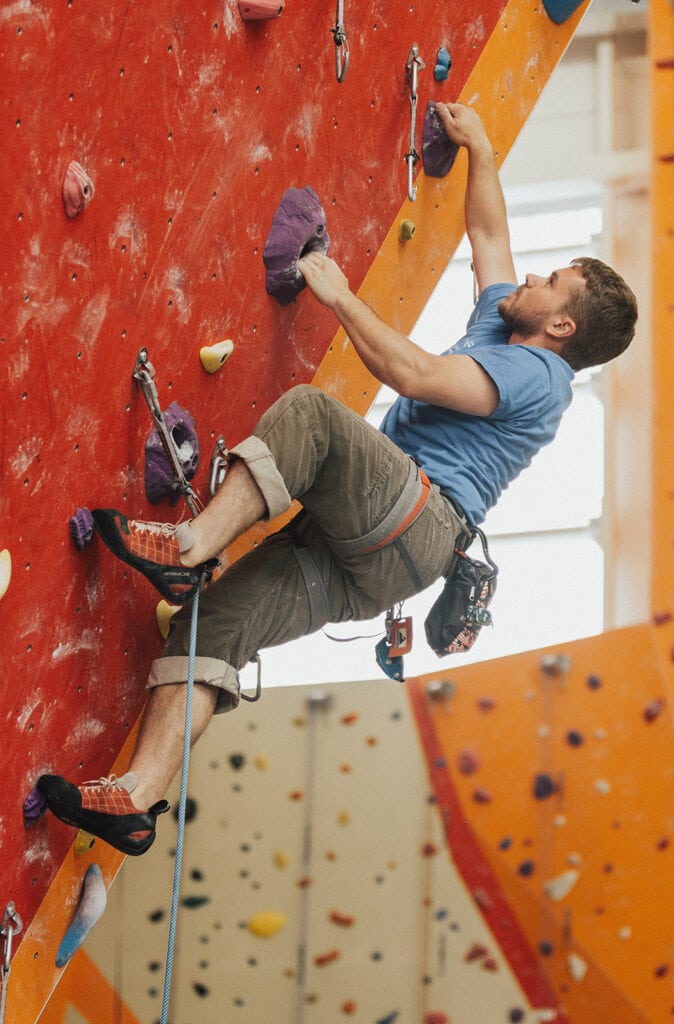
What is a climbing harness?
A climbing harness is a piece of apparel that attaches a climber and their belayer to the rope. Harnesses are crucial for any style of roped climbing, from sport climbing to trad and alpine climbing, and they’re also required for rappelling.
Climbing harnesses are also used in a variety of professional settings involving high angles, including industrial work, construction, and rescue operations.
Construction
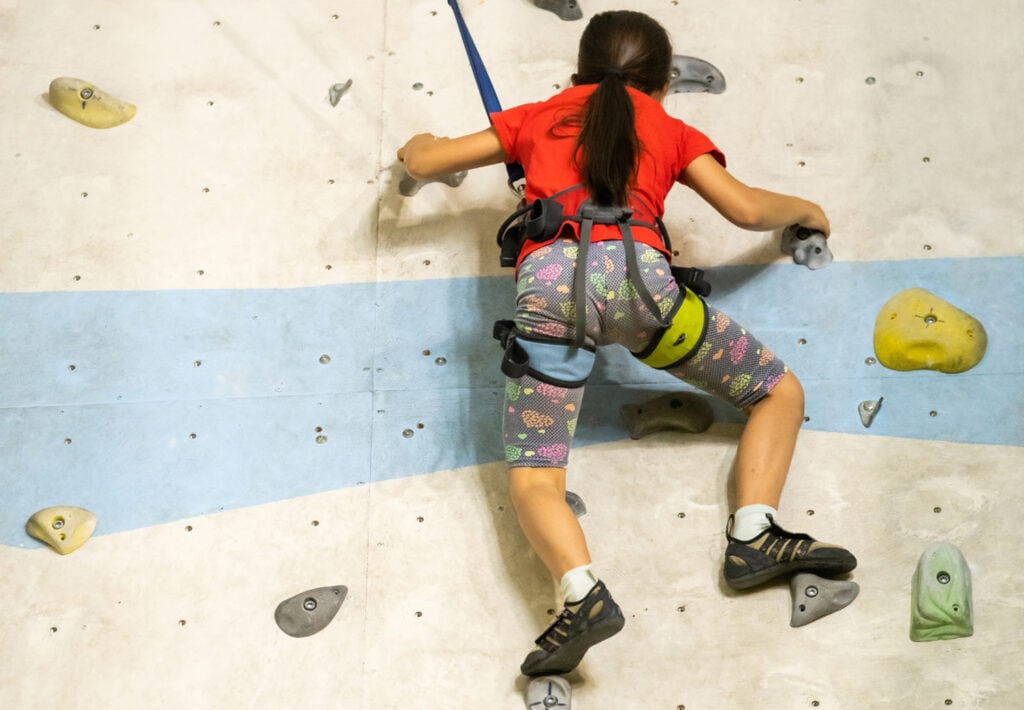
There are two types of harnesses: sit harnesses and full-body harnesses. The former consists of a pair of leg loops and a waist belt, forming a “seat” for the climber. This is the most common harness used in rock climbing. The latter adds a chest harness, worn around the shoulders, to prevent any chance of slipping out of the harness if the climber flips upside down. Full-body harnesses are often used by young children or disabled climbers. They are also useful in rope access work, where an individual may be carrying a heavy load on their back.
The following are the key components of a traditional sit-style climbing harness.
Waist Belt
The waist belt is the upper, adjustable strap of webbing running around the climber’s waist. It is usually loosened or tightened via a one or two-buckle system. Waist belts are thicker than leg loops and often padded, and serve as one of the two attachment points for your tie-in knot. Gear loops are strung around the edges of the waist belt.
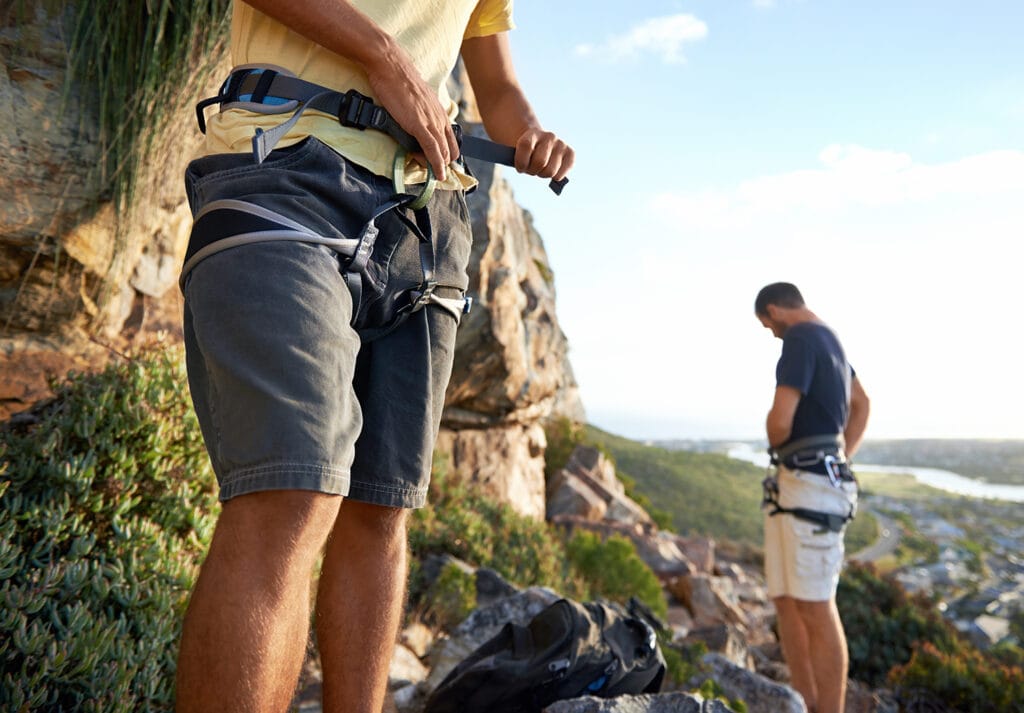
Leg Loops
Each harness has two leg loops, thinner straps of webbing that wrap around the climber’s upper thighs. Sometimes these straps are adjustable, sometimes not. Designs vary, but usually, both leg loops have an additional band of webbing that ties them together and to the belay loop. The meeting point of the leg loops provides the second attachment point for the climber’s tie-in knot.
Belay Loop
The belay loop is a small, thick band of webbing that runs vertically between the leg loops and waist belt in the climber’s groin, serving as the primary point of attachment between the leg loops and waist belt. While generally no longer used as a tie-in point due to lack of redundancy, the belay loop is where the climber’s belay or rappel device is attached.
Gear Loops
A gear loop is a small, non-load-bearing loop used to carry climbing gear such as carabiners, quickdraws, cams, nuts, cordelette, and slings. Gear loops aren’t included on all climbing harnesses but are a must-have for any outdoor lead harness. For ice and alpine harnesses, ice clipper slots are also helpful. (These are like smaller, vertical loops specifically designed to hang a carabiner so you can rack ice screws).
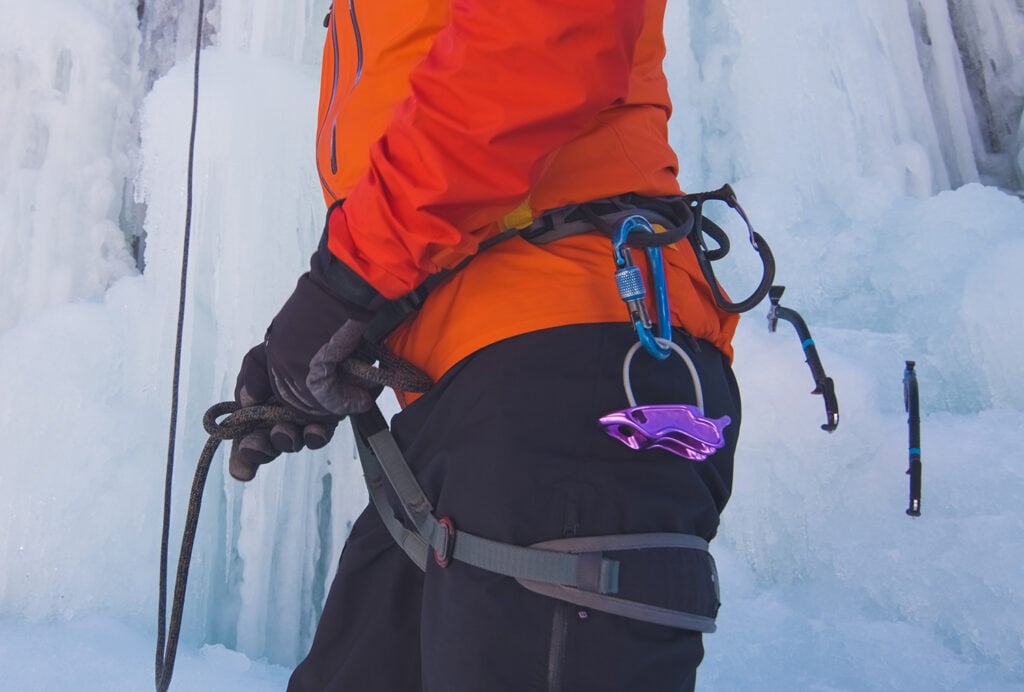
Materials
Most modern climbing harnesses are primarily constructed using nylon webbing, with a variety of different weaves depending on the function of a given part. It can also feature closed-cell foam padding and mesh to improve comfort and breathability.
Polyester, aramid fibers like Kevlar, UHMWPE (Ultra High Molecular Weight Polyethylene), and other fabrics are also sometimes incorporated to reduce weight, improve comfort, and add durability, among other factors. Last but not least, a climbing harness buckle is usually made of anodized aluminum.
How it works
This is fairly self-explanatory. A climbing harness works by securing the climber’s legs and waist and providing an attachment point for their rope, positioned so that it catches the climber and keeps their center of gravity balanced and upright in a wide variety of fall scenarios. If a harness is well-designed, then its wearer is safely caught (with minimal discomfort) in the event of a fall.
Important Criteria

Comfort
All the harnesses on this list will keep you safe if they’re used correctly and properly cared for. So what it really comes down to is comfort. Remember, every second you’re on the rope, whether you’re belaying, rappeling, or actually climbing, you’ll be tied into your harness. It pays to make sure it’s a comfy one.
Climbing

A harnesses should be comfortable while climbing, allowing a high level of movement and flexibility. It’s never as easy to climb in a harness as it is without one, but your harness should hinder your performance as little as possible. Ensure you can high step, stem, flag, and perform all manner of climbing movements in your harness without any restriction.
Hanging
It’s not all about the actual climbing! The best harnesses should be comfortable to wear for long periods of time, such as while belaying, rappeling, or jugging fixed lines. Ultimately, the best choice depends on the style of climbing you’re doing. If you’re doing multi-pitch routes, then a heavily-padded, breathable harness that is comfortable for hours (or days!) on the wall is a good idea. If you’re mostly climbing sport routes or in the gym, then you probably won’t be doing much hanging and can forgo the extra padding.
Fit & sizing
The waist belt of your harness should wrap above your hip bones (iliac crest). It should also be tight enough that you can’t pull it down. In addition, make sure to find a harness size that, when fitted properly, has the waist buckle about halfway through its total range (in other words, not completely tightened or completely loosened). This will give you wiggle room on either end and always let you get a snug, secure fit.
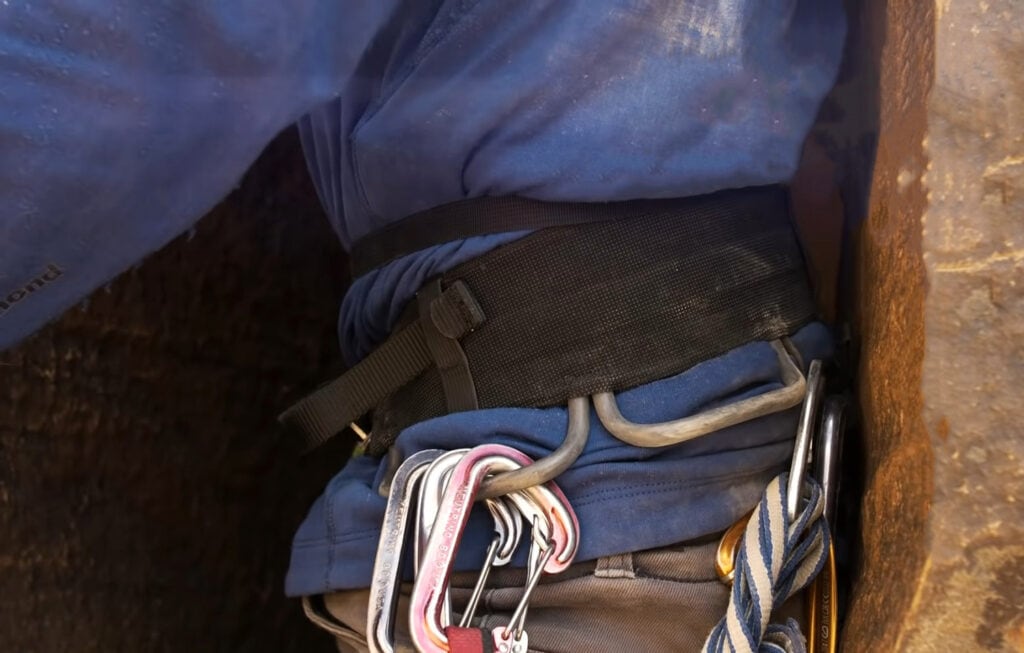
Your leg loops should be comfortable, and not extremely snug. A secure fit on the waist is crucial, but the leg loops are primarily there to stop you from slipping out of the waistbelt. When adjusted properly, you should be able to easily slide your hand between your leg and the harness.
Adjustability
Pretty much all climbing harnesses are adjustable at the waist, but not all have adjustable leg loops. In some cases, like the TK, this is a good thing. It makes it easy to simply slip the harness on and off in-between sessions. If you’re going to be on the wall for a long period of time, however (or in a more dangerous scenario like trad climbing where you need maximum protection), then it pays to find a harness with fully adjustable leg loops so you can be completely locked in.
Weight
Climbing harnesses weigh anywhere between 20 ounces and a mere 3 ounces, although most clock in somewhere between 12 and 16 ounces. Lightweight harnesses are always nice, but weight isn’t always directly correlated with comfort (padding adds weight!) so don’t stress too much about weight when you’re first starting out on the wall.
Versatility

Gear loops
Gear loops are found on most climbing harnesses. The only situation where you won’t need gear loops on a harness is if you’re top roping or leading a route with pre-fixed draws and permadraw anchors, such as in an indoor climbing gym. Otherwise, make sure your harness has at least two gear loops for sport and gym climbing and four for anything else. Some harnesses even have five, but unless you’re big walling or aiding, you probably won’t need that many. Remember, gear loops are usually not weight-bearing, and should never be used as attachment points! (Ice clipper slots (see above) are also incorporated in some harness models to specifically rack ice gear.)
Haul loop
A haul loop is a small loop on the center rear of the harness. Most modern climbing harnesses come with a haul loop, but they’re only used in specific situations. In theory, haul loops are used either to haul gear (as the name suggests) or carry a tagline or extra rope up the wall. For gym climbing, top rope, sport climbing, and single-pitch trad climbing scenarios, a haul loop is unnecessary. But if you plan on tackling El Cap in your new harness, you’ll want a haul loop on your harness.
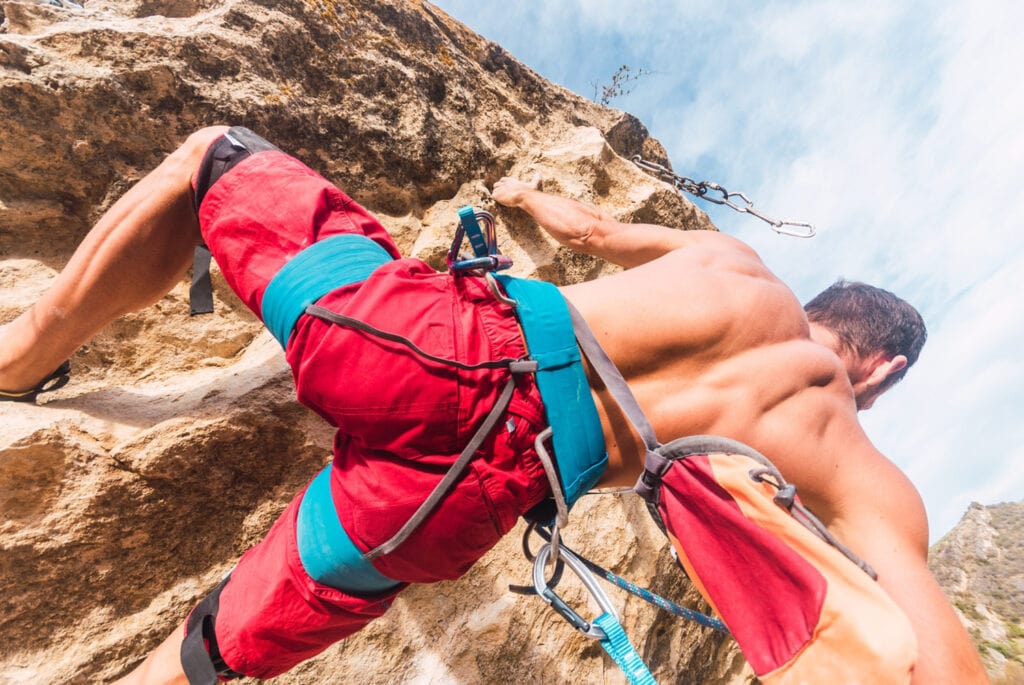
Extra attachment points
Most climbing harnesses will only have a single attachment point (the belay loop), along with two tie-in loops for your knot. 99% of the time this is all you need. There are some unique cases, like rope access work or certain big wall aid situations, where an extra attachment point could come in handy. Maybe you’d simply like to make your belay loop redundant for peace of mind. (The Black Diamond Long Haul (5) is a good choice in this case.)
Packability
If you’re climbing at the gym or at a crag that’s five minutes from the car, maybe packability is no big deal. But if you’re ever on a 30-minute approach, you’ll regret it. Hiking in a climbing harness on a long, tiring approach is no fun. It’s best to purchase a harness you can easily fold and stuff into your pack.
Types and Styles
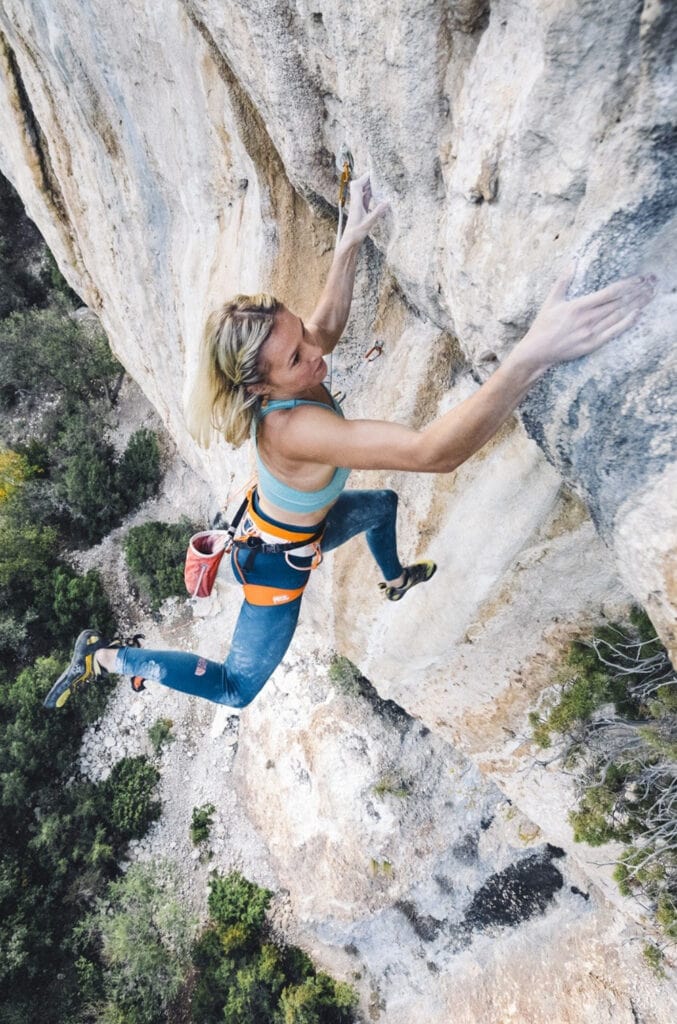
Sit vs. full-body harnesses
As mentioned above, there are two types of harnesses: sit harnesses and full-body harnesses. Sit harnesses feature a waist belt and a pair of leg loops, which together form a “seat” for the climber. Sit harnesses are the most common harnesses used in climbing.
Full-body harnesses are sit harnesses with an added chest harness, worn around the shoulders, which prevents the wearer from slipping out of their harness if they flip upside down. These harnesses are often used by young children, climbers with disabilities or during pregnancy. They are also commonly used in high-angle industrial work, where the climber may be carrying a heavy load on their back that could shift them off balance.
Use
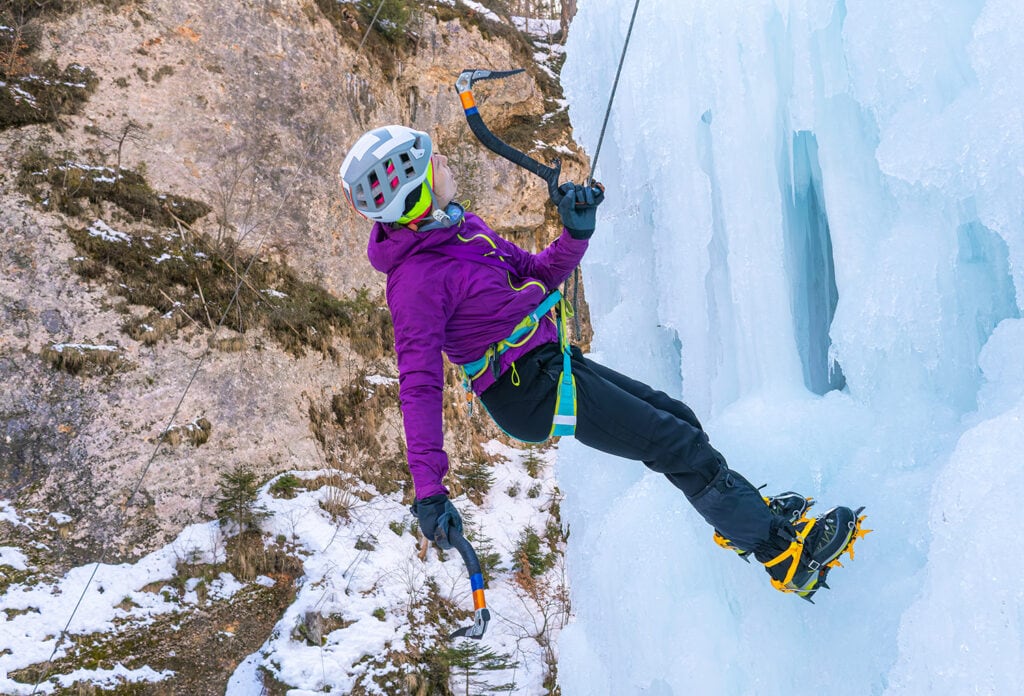
Climbing harnesses and high-angle work harnesses (like those for construction, industrial work, painting, and the like) have many differences. But even in the world of pure rock climbing, harnesses are designed with specific uses in mind.
For example, in comparison to sport climbing harnesses, trad or multi-pitch climbing harnesses usually feature extra padding and ventilation, as well as additional gear loops and a haul loop. Harnesses designed for alpine climbing and mountaineering are often made so that the leg loops can be put on without removing boots or crampons.
How Safe is a Climbing Harness?

Safety standards & testing
Like all climbing gear, harnesses are rated by the weight they can safely hold. This force is measured in kilo Newtons (kN). A single kN is around 224 pounds of holding power. On Type C sit harnesses (like those mentioned in this article), UIAA and EN standards require that the belay loop must be rated to at least 15kN (3,372 lbs).
Harness failure almost never happens, but it can occur. If a serious failure does occur, it’s usually in the belay loop, like in the case of Todd Skinner (6), a Yosemite legend who died while rappeling after his belay loop snapped. The belay loop is one of the only key points on your harness that isn’t redundant so it’s critical that you keep it in good condition. (While both the waistbelt and each individual leg loop don’t seem redundant either, technically, in reality, if any one of those three were to break, the other two would likely arrest a fall enough for you to remedy the situation temporarily until you can get down from the wall.

The belay loop is the spot on the harness that will probably see the most use since it’s your attachment point for belaying and rappelling. So monitor the condition of your harness and particularly your belay loop. And remember that webbing degrades over time, regardless of use. You must retire a climbing harness after no more than seven years (at least), even if it’s in seemingly perfect condition.
Remember, a more expensive harness isn’t always safer. Price is relative to a variety of factors, such as weight, breathability, packability, versatility, and comfort. All the climbing harnesses in this article will keep you safe if they are kept in good condition and retired at the end of their lifespan.
When to replace a harness

Harnesses don’t last forever. Retire your climbing harness when it shows signs of excessive wear. Any tears, fraying, and particularly visible damage to the belay loop or structural components of the harness is cause for immediate retirement. Regardless of any visible damage, retire all harnesses after seven years, maximum. Harnesses that are regularly used can reach the end of their lifespan in as little as a year.
As you consider retirement, ask yourself: Is the webbing ripped, frayed, or discolored? Are any harness buckles damaged? Is there any excessive abrasion on the bar tacks? Some harnesses also feature a built-in wear indicator on the belay loop. If you can see your wear indicator, it’s time to shop for a new harness.
Second hand buying
While buying a used climbing harness can seem appealing to save a few bucks, it’s really important to be careful. You must inspect the harness thoroughly and get detailed information from the owner about its history (e.g., purchase date, type of use) to make an informed and safe decision. If you have any doubts, buy a new one.
References
Black Diamond Solution Guide Harness – Women’s
REI (retrieved on 28/06/2023)
https://www.rei.com/product/149647/black-diamond-solution-guide-harness-womens
Black Diamond Momentum Harness – Women’s
REI (retrieved on 28/06/2023)
https://www.rei.com/product/162873/black-diamond-momentum-harness-womens
Edelrid Jayne Harness – Women’s
REI (retrieved on 28/06/2023)
https://www.rei.com/product/221396/edelrid-jayne-harness-womens
Plus Size Climbing Harnesses: Resources & Measurements
The Mountaineers (retrieved on 28/06/2023)
https://www.mountaineers.org/blog/plus-size-climbing-harnesses-resources-measurements
Black Diamond Long Haul Harness
REI (retrieved on 28/06/2023)
https://www.rei.com/product/221873/black-diamond-long-haul-harness
Todd Skinner: Loss of a Legend
Climbing (retrieved on 28/06/2023)
https://www.climbing.com/news/loss-of-a-legend/

